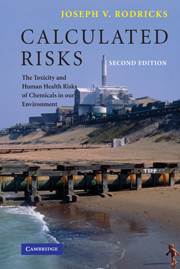Book contents
- Frontmatter
- Contents
- Preface to the first edition
- Preface to the second edition
- List of abbreviations
- Prologue
- 1 Chemicals and chemical exposures
- 2 From exposure to dose
- 3 From dose to toxic response
- 4 Toxic agents and their targets
- 5 Carcinogens
- 6 Identifying carcinogens
- 7 Risk assessment I: some concepts and principles
- 8 Risk assessment II: applications
- 9 Risk assessment III: new approaches, new problems
- 10 Risk assessment IV: the courtroom
- 11 The management of risk
- 12 A look ahead
- Sources and recommended reading
- Index
3 - From dose to toxic response
Published online by Cambridge University Press: 25 August 2009
- Frontmatter
- Contents
- Preface to the first edition
- Preface to the second edition
- List of abbreviations
- Prologue
- 1 Chemicals and chemical exposures
- 2 From exposure to dose
- 3 From dose to toxic response
- 4 Toxic agents and their targets
- 5 Carcinogens
- 6 Identifying carcinogens
- 7 Risk assessment I: some concepts and principles
- 8 Risk assessment II: applications
- 9 Risk assessment III: new approaches, new problems
- 10 Risk assessment IV: the courtroom
- 11 The management of risk
- 12 A look ahead
- Sources and recommended reading
- Index
Summary
It is difficult to doubt that the earliest human beings, and perhaps even some of their evolutionary predecessors, were aware of poisons in their environments. For as long as human beings have walked the earth they have been stung or bitten by poisonous insects and animals. In their search for nourishing foods, mostly through trial and error, some early members of the species no doubt were sickened by or even succumbed to the consumption of the many plants that contain highly toxic constituents. Somewhere in prerecorded time, human beings also learned that certain plants could alleviate pain or remedy certain afflictions; learning about these plants probably also taught them a great deal about unpleasant side effects.
Those early metallurgists who were clever enough to learn how to transform crude ores to shiny metals were probably also observant enough to discover that some of the materials being worked with could harm them. Some of the earliest written accounts of humans on earth provide evidence that the ancient Greeks and Romans were well aware of the poisonous properties of certain plants and metals. The case of the poisoning of Socrates with hemlock is only the most famous of the early references to the deliberate use of certain plants for suicidal or homicidal purposes.
The science of toxicology, which we define as the study of the adverse effects of chemicals on health and of the conditions under which those effects occur, has begun to take on a well-defined shape only in the past four to five decades.
- Type
- Chapter
- Information
- Calculated RisksThe Toxicity and Human Health Risks of Chemicals in our Environment, pp. 54 - 90Publisher: Cambridge University PressPrint publication year: 2006

